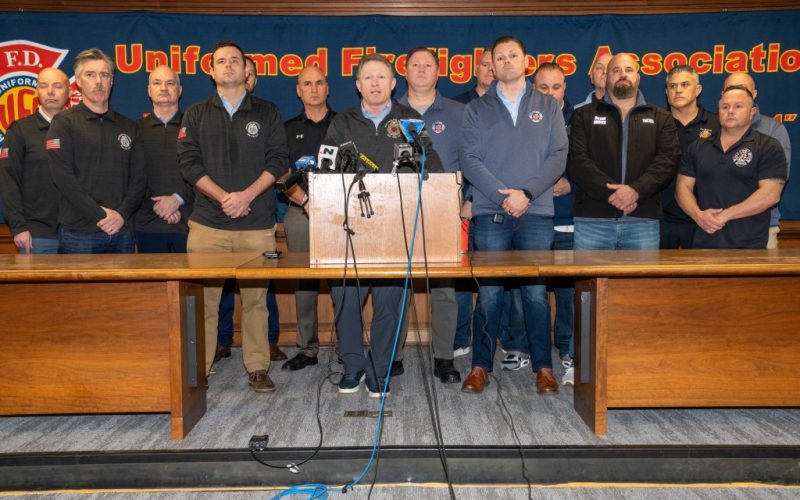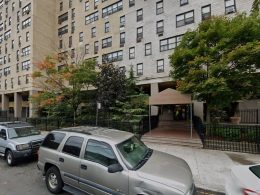As New York City ushered in its long-awaited congestion pricing plan, the FDNY sounded the alarm over what it calls a looming public safety crisis — one they warn could mean slower response times, longer shifts and millions of dollars in extra costs.
The tolling program, the first of its kind in the United States, was introduced just after midnight on Sunday, and imposes a toll on drivers entering Manhattan’s busiest areas, including parts of the Financial District, Midtown, and Lower Manhattan. The additional $9 fee has long sparked controversy, but the city’s firefighters are now raising urgent concerns about its impact on emergency services.
“The department moves 200 firefighters a day to different firehouses,” said Jim Brosi, president of the Uniformed Fire Officers Association. “Now, because of congestion pricing, we’ve got a situation where many firefighters don’t want to pay that toll. They’re opting for public transportation instead, and that’s creating an entirely new set of problems.”
According to Brosi, a number of New York’s bravest use their personal vehicles to drive to firehouses in need of additional personnel, but the newly imposed toll is making that financially unfeasible for many, forcing the department to rely on a fleet of just 15 vans to transport firefighters. These vehicles, typically reserved for other tasks — like picking up equipment or visiting injured members — will now be stretched thin to shuttle firefighters between stations.
Theodore Parisienne / New York Daily News
Cars are tolled entering Manhattan from the Brooklyn Bridge on the first day of congestion pricing on Sunday. (Theodore Parisienne / New York Daily News)
“The problem is, these vans can only fit four or five firefighters at a time,” Brosi explained at a Sunday news conference. “We’re talking about moving dozens of people every day, but we don’t have the vehicles to do it. This is going to slow things down, and when that happens, the people who are waiting for relief are forced to stay on the job longer — meaning more overtime.”
The bottleneck could mean firefighters waiting for relief are forced to stay longer at their posts, resulting in an additional $1.8 million in estimated overtime pay, according to Brosi. The union head also stressed the possibility of delays in getting manpower to stations where they’re most needed.
“We’re not talking about a theoretical problem here,” said Brosi. “In a city like New York, with its unique and often complex buildings, you need experienced firefighters. Losing that institutional knowledge, because people are being delayed, is a huge issue. If we can’t get our guys in place on time, it could mean lives lost.”
The FDNY’s concerns are compounded by the need for firefighters to return to their original firehouses at the end of the day to secure equipment, change, and decontaminate — adding more strain to an already strained system.

Theodore Parisienne / New York Daily News
James Brosi (left), President of the Uniformed Fire Officers Association and Andrew Ansbro, President of the Uniformed Firefighters Association hold a press conference on congestion pricing on Sunday. (Theodore Parisienne / New York Daily News)
The FDNY’s request for an exemption for those working inside the toll zone was denied. Brosi stressted they were not asking for a department-wide exemption, just a carve-out for the firefighters who are most affected.
“We didn’t ask for an exemption for all firefighters,” said Brosi. “We asked for an exemption for the 10% of our members who work in the business district. Just a little help to keep them driving to work. If we had that, we’d still have access to their vehicles for transfers, and we wouldn’t be losing vital manpower.”
“We didn’t ask for the world,” the exasperated union head added. “But we were told no.”
Brosi worries the increased costs and logistical headaches could lead to personnel issues down the line, as seasoned members of the department could transfer out or retire early as their toll bills explode.
“We’re already struggling with recruitment and retention,” he said. “If we lose our veterans, we lose years of experience. And that makes the whole city less safe.”
Despite the FDNY’s concerns, MTA Chair Janno Lieber defended the plan at a separate Sunday news conference, emphasizing the program’s intention to reduce gridlock, improve emergency response times and encourage\ the use of public transportation.
“We understand the concerns of the FDNY, but the ultimate goal of this program is to make traffic flow more smoothly, not just for commuters, but for emergency vehicles too,” Lieber said. “The idea is to reduce delays and allow fire trucks, ambulances, and police cars to get to where they need to go faster.”

Barry Williams/ New York Daily News
A congestion pricing warning sign on Columbus Ave. and W. 61st St. in Manhattan. (Barry Williams/ New York Daily News)
The new toll is expected to climb over time and will increase to $12 by 2028, and then $15 by 2031 — all aimed at funding upgrades and improvements to the city’s mass transit system.
The MTA’s promise of a smoother subway system and less congestion has done little to reassure Brosi and his colleagues, who argue the city’s long-term vision will have immediate and serious consequences for emergency services.
“The MTA keeps talking about long-term benefits, but in the short term, we’re the ones who are going to pay the price. And it’s the public who will suffer,” Brosi said. “We’ve been asking for help, but no one’s listening.”








